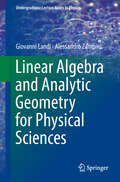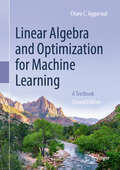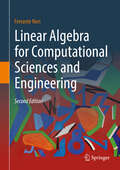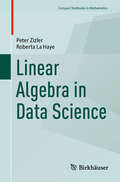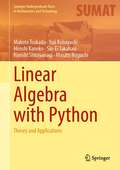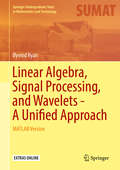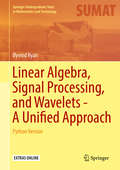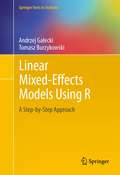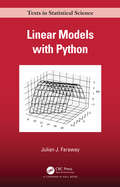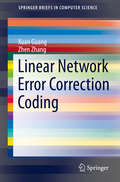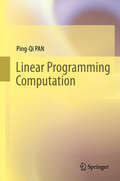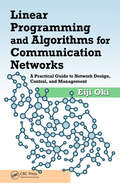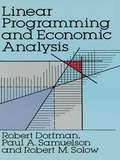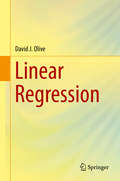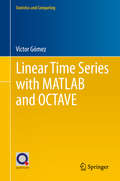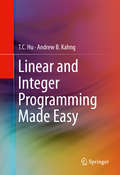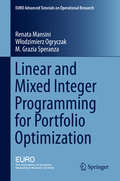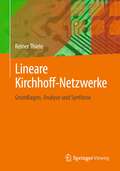- Table View
- List View
Linear Algebra and Analytic Geometry for Physical Sciences (Undergraduate Lecture Notes in Physics)
by Giovanni Landi Alessandro ZampiniA self-contained introduction to finite dimensional vector spaces, matrices, systems of linear equations, spectral analysis on euclidean and hermitian spaces, affine euclidean geometry, quadratic forms and conic sections. The mathematical formalism is motivated and introduced by problems from physics, notably mechanics (including celestial) and electro-magnetism, with more than two hundreds examples and solved exercises.Topics include: The group of orthogonal transformations on euclidean spaces, in particular rotations, with Euler angles and angular velocity. The rigid body with its inertia matrix. The unitary group. Lie algebras and exponential map. The Dirac’s bra-ket formalism. Spectral theory for self-adjoint endomorphisms on euclidean and hermitian spaces. The Minkowski spacetime from special relativity and the Maxwell equations. Conic sections with the use of eccentricity and Keplerian motions. An appendix collects basic algebraic notions like group, ring and field; and complex numbers and integers modulo a prime number.The book will be useful to students taking a physics or engineer degree for a basic education as well as for students who wish to be competent in the subject and who may want to pursue a post-graduate qualification.
Linear Algebra and Optimization for Machine Learning: A Textbook
by Charu C. AggarwalThis textbook introduces linear algebra and optimization in the context of machine learning. Examples and exercises are provided throughout this text book together with access to a solution’s manual. This textbook targets graduate level students and professors in computer science, mathematics and data science. Advanced undergraduate students can also use this textbook. The chapters for this textbook are organized as follows:1. Linear algebra and its applications: The chapters focus on the basics of linear algebra together with their common applications to singular value decomposition, matrix factorization, similarity matrices (kernel methods), and graph analysis. Numerous machine learning applications have been used as examples, such as spectral clustering, kernel-based classification, and outlier detection. The tight integration of linear algebra methods with examples from machine learning differentiates this book from generic volumes on linear algebra. The focus is clearly on the most relevant aspects of linear algebra for machine learning and to teach readers how to apply these concepts.2. Optimization and its applications: Much of machine learning is posed as an optimization problem in which we try to maximize the accuracy of regression and classification models. The “parent problem” of optimization-centric machine learning is least-squares regression. Interestingly, this problem arises in both linear algebra and optimization, and is one of the key connecting problems of the two fields. Least-squares regression is also the starting point for support vector machines, logistic regression, and recommender systems. Furthermore, the methods for dimensionality reduction and matrix factorization also require the development of optimization methods. A general view of optimization in computational graphs is discussed together with its applications to back propagation in neural networks. A frequent challenge faced by beginners in machine learning is the extensive background required in linear algebra and optimization. One problem is that the existing linear algebra and optimization courses are not specific to machine learning; therefore, one would typically have to complete more course material than is necessary to pick up machine learning. Furthermore, certain types of ideas and tricks from optimization and linear algebra recur more frequently in machine learning than other application-centric settings. Therefore, there is significant value in developing a view of linear algebra and optimization that is better suited to the specific perspective of machine learning.
Linear Algebra and Optimization for Machine Learning: A Textbook
by Charu C. AggarwalThis textbook is the second edition of the linear algebra and optimization book that was published in 2020. The exposition in this edition is greatly simplified as compared to the first edition. The second edition is enhanced with a large number of solved examples and exercises. A frequent challenge faced by beginners in machine learning is the extensive background required in linear algebra and optimization. One problem is that the existing linear algebra and optimization courses are not specific to machine learning; therefore, one would typically have to complete more course material than is necessary to pick up machine learning. Furthermore, certain types of ideas and tricks from optimization and linear algebra recur more frequently in machine learning than other application-centric settings. Therefore, there is significant value in developing a view of linear algebra and optimization that is better suited to the specific perspective of machine learning. It is common for machine learning practitioners to pick up missing bits and pieces of linear algebra and optimization via &“osmosis&” while studying the solutions to machine learning applications. However, this type of unsystematic approach is unsatisfying because the primary focus on machine learning gets in the way of learning linear algebra and optimization in a generalizable way across new situations and applications. Therefore, we have inverted the focus in this book, with linear algebra/optimization as the primary topics of interest, and solutions to machine learning problems as the applications of this machinery. In other words, the book goes out of its way to teach linear algebra and optimization with machine learning examples. By using this approach, the book focuses on those aspects of linear algebra and optimization that are more relevant to machine learning, and also teaches the reader how to apply them in the machine learning context. As a side benefit, the reader will pick up knowledge of several fundamental problems in machine learning. At the end of the process, the reader will become familiar with many of the basic linear-algebra- and optimization-centric algorithms in machine learning. Although the book is not intended to provide exhaustive coverage of machine learning, it serves as a &“technical starter&” for the key models and optimization methods in machine learning. Even for seasoned practitioners of machine learning, a systematic introduction to fundamental linear algebra and optimization methodologies can be useful in terms of providing a fresh perspective. The chapters of the book are organized as follows. 1-Linear algebra and its applications: The chapters focus on the basics of linear algebra together with their common applications to singular value decomposition, matrix factorization, similarity matrices (ker
Linear Algebra for Computational Sciences and Engineering
by Ferrante NeriThis book presents the main concepts of linear algebra from the viewpoint of applied scientists such as computer scientists and engineers, without compromising on mathematical rigor. Based on the idea that computational scientists and engineers need, in both research and professional life, an understanding of theoretical concepts of mathematics in order to be able to propose research advances and innovative solutions, every concept is thoroughly introduced and is accompanied by its informal interpretation. Furthermore, most of the theorems included are first rigorously proved and then shown in practice by a numerical example. When appropriate, topics are presented also by means of pseudocodes, thus highlighting the computer implementation of algebraic theory.It is structured to be accessible to everybody, from students of pure mathematics who are approaching algebra for the first time to researchers and graduate students in applied sciences who need a theoretical manual of algebra to successfully perform their research. Most importantly, this book is designed to be ideal for both theoretical and practical minds and to offer to both alternative and complementary perspectives to study and understand linear algebra.
Linear Algebra in Data Science (Compact Textbooks in Mathematics)
by Peter Zizler Roberta La HayeThis textbook explores applications of linear algebra in data science at an introductory level, showing readers how the two are deeply connected. The authors accomplish this by offering exercises that escalate in complexity, many of which incorporate MATLAB. Practice projects appear as well for students to better understand the real-world applications of the material covered in a standard linear algebra course. Some topics covered include singular value decomposition, convolution, frequency filtering, and neural networks. Linear Algebra in Data Science is suitable as a supplement to a standard linear algebra course.
Linear Algebra with Python: Theory and Applications (Springer Undergraduate Texts in Mathematics and Technology)
by Makoto Tsukada Yuji Kobayashi Hiroshi Kaneko Sin-Ei Takahasi Kiyoshi Shirayanagi Masato NoguchiThis textbook is for those who want to learn linear algebra from the basics. After a brief mathematical introduction, it provides the standard curriculum of linear algebra based on an abstract linear space. It covers, among other aspects: linear mappings and their matrix representations, basis, and dimension; matrix invariants, inner products, and norms; eigenvalues and eigenvectors; and Jordan normal forms. Detailed and self-contained proofs as well as descriptions are given for all theorems, formulas, and algorithms. A unified overview of linear structures is presented by developing linear algebra from the perspective of functional analysis. Advanced topics such as function space are taken up, along with Fourier analysis, the Perron–Frobenius theorem, linear differential equations, the state transition matrix and the generalized inverse matrix, singular value decomposition, tensor products, and linear regression models. These all provide a bridge to more specialized theories based on linear algebra in mathematics, physics, engineering, economics, and social sciences. Python is used throughout the book to explain linear algebra. Learning with Python interactively, readers will naturally become accustomed to Python coding. By using Python’s libraries NumPy, Matplotlib, VPython, and SymPy, readers can easily perform large-scale matrix calculations, visualization of calculation results, and symbolic computations. All the codes in this book can be executed on both Windows and macOS and also on Raspberry Pi.
Linear Algebra, Signal Processing, and Wavelets - A Unified Approach: MATLAB Version (Springer Undergraduate Texts in Mathematics and Technology)
by Øyvind RyanThis book offers a user friendly, hands-on, and systematic introduction to applied and computational harmonic analysis: to Fourier analysis, signal processing and wavelets; and to their interplay and applications. The approach is novel, and the book can be used in undergraduate courses, for example, following a first course in linear algebra, but is also suitable for use in graduate level courses. The book will benefit anyone with a basic background in linear algebra. It defines fundamental concepts in signal processing and wavelet theory, assuming only a familiarity with elementary linear algebra. No background in signal processing is needed. Additionally, the book demonstrates in detail why linear algebra is often the best way to go. Those with only a signal processing background are also introduced to the world of linear algebra, although a full course is recommended. The book comes in two versions: one based on MATLAB, and one on Python, demonstrating the feasibility and applications of both approaches. Most of the MATLAB code is available interactively. The applications mainly involve sound and images. The book also includes a rich set of exercises, many of which are of a computational nature.
Linear Algebra, Signal Processing, and Wavelets - A Unified Approach: Python Version (Springer Undergraduate Texts in Mathematics and Technology)
by Øyvind RyanThis book offers a user friendly, hands-on, and systematic introduction to applied and computational harmonic analysis: to Fourier analysis, signal processing and wavelets; and to their interplay and applications. The approach is novel, and the book can be used in undergraduate courses, for example, following a first course in linear algebra, but is also suitable for use in graduate level courses. The book will benefit anyone with a basic background in linear algebra. It defines fundamental concepts in signal processing and wavelet theory, assuming only a familiarity with elementary linear algebra. No background in signal processing is needed. Additionally, the book demonstrates in detail why linear algebra is often the best way to go. Those with only a signal processing background are also introduced to the world of linear algebra, although a full course is recommended.The book comes in two versions: one based on MATLAB, and one on Python, demonstrating the feasibility and applications of both approaches. Most of the code is available interactively. The applications mainly involve sound and images. The book also includes a rich set of exercises, many of which are of a computational nature.
Linear Mixed-Effects Models Using R
by Tomasz Burzykowski Andrzej GałeckiLinear mixed-effects models (LMMs) are an important class of statistical models that can be used to analyze correlated data. Such data are encountered in a variety of fields including biostatistics, public health, psychometrics, educational measurement, and sociology. This book aims to support a wide range of uses for the models by applied researchers in those and other fields by providing state-of-the-art descriptions of the implementation of LMMs in R. To help readers to get familiar with the features of the models and the details of carrying them out in R, the book includes a review of the most important theoretical concepts of the models. The presentation connects theory, software and applications. It is built up incrementally, starting with a summary of the concepts underlying simpler classes of linear models like the classical regression model, and carrying them forward to LMMs. A similar step-by-step approach is used to describe the R tools for LMMs. All the classes of linear models presented in the book are illustrated using real-life data. The book also introduces several novel R tools for LMMs, including new class of variance-covariance structure for random-effects, methods for influence diagnostics and for power calculations. They are included into an R package that should assist the readers in applying these and other methods presented in this text.<P> Advisory: Bookshare has learned that this book offers only partial accessibility. We have kept it in the collection because it is useful for some of our members. To explore further access options with us, please contact us through the Book Quality link on the right sidebar. Benetech is actively working on projects to improve accessibility issues such as these.
Linear Models with Python (Chapman & Hall/CRC Texts in Statistical Science)
by Julian J. FarawayPraise for Linear Models with R: This book is a must-have tool for anyone interested in understanding and applying linear models. The logical ordering of the chapters is well thought out and portrays Faraway’s wealth of experience in teaching and using linear models. … It lays down the material in a logical and intricate manner and makes linear modeling appealing to researchers from virtually all fields of study. -Biometrical Journal Throughout, it gives plenty of insight … with comments that even the seasoned practitioner will appreciate. Interspersed with R code and the output that it produces one can find many little gems of what I think is sound statistical advice, well epitomized with the examples chosen…I read it with delight and think that the same will be true with anyone who is engaged in the use or teaching of linear models. -Journal of the Royal Statistical Society Like its widely praised, best-selling companion version, Linear Models with R, this book replaces R with Python to seamlessly give a coherent exposition of the practice of linear modeling. Linear Models with Python offers up-to-date insight on essential data analysis topics, from estimation, inference and prediction to missing data, factorial models and block designs. Numerous examples illustrate how to apply the different methods using Python. Features: Python is a powerful, open source programming language increasingly being used in data science, machine learning and computer science. Python and R are similar, but R was designed for statistics, while Python is multi-talented. This version replaces R with Python to make it accessible to a greater number of users outside of statistics, including those from Machine Learning. A reader coming to this book from an ML background will learn new statistical perspectives on learning from data. Topics include Model Selection, Shrinkage, Experiments with Blocks and Missing Data. Includes an Appendix on Python for beginners. Linear Models with Python explains how to use linear models in physical science, engineering, social science and business applications. It is ideal as a textbook for linear models or linear regression courses.
Linear Network Error Correction Coding
by Xuan Guang Zhen ZhangThere are two main approaches in the theory of network error correction coding. In this SpringerBrief, the authors summarize some of the most important contributions following the classic approach, which represents messages by sequences similar to algebraic coding, and also briefly discuss the main results following the other approach, that uses the theory of rank metric codes for network error correction of representing messages by subspaces. This book starts by establishing the basic linear network error correction (LNEC) model and then characterizes two equivalent descriptions. Distances and weights are defined in order to characterize the discrepancy of these two vectors and to measure the seriousness of errors. Similar to classical error-correcting codes, the authors also apply the minimum distance decoding principle to LNEC codes at each sink node, but use distinct distances. For this decoding principle, it is shown that the minimum distance of a LNEC code at each sink node can fully characterize its error-detecting, error-correcting and erasure-error-correcting capabilities with respect to the sink node. In addition, some important and useful coding bounds in classical coding theory are generalized to linear network error correction coding, including the Hamming bound, the Gilbert-Varshamov bound and the Singleton bound. Several constructive algorithms of LNEC codes are presented, particularly for LNEC MDS codes, along with an analysis of their performance. Random linear network error correction coding is feasible for noncoherent networks with errors. Its performance is investigated by estimating upper bounds on some failure probabilities by analyzing the information transmission and error correction. Finally, the basic theory of subspace codes is introduced including the encoding and decoding principle as well as the channel model, the bounds on subspace codes, code construction and decoding algorithms.
Linear Programming Computation
by Ping-Qi PanWith emphasis on computation, this book is a real breakthrough in the field of LP. In addition to conventional topics, such as the simplex method, duality, and interior-point methods, all deduced in a fresh and clear manner, it introduces the state of the art by highlighting brand-new and advanced results, including efficient pivot rules, Phase-I approaches, reduced simplex methods, deficient-basis methods, face methods, and pivotal interior-point methods. In particular, it covers the determination of the optimal solution set, feasible-point simplex method, decomposition principle for solving large-scale problems, controlled-branch method based on generalized reduced simplex framework for solving integer LP problems.
Linear Programming Using MATLAB® (Springer Optimization and Its Applications #127)
by Nikolaos Ploskas Nikolaos SamarasThis book offers a theoretical and computational presentation of a variety of linear programming algorithms and methods with an emphasis on the revised simplex method and its components. A theoretical background and mathematical formulation is included for each algorithm as well as comprehensive numerical examples and corresponding MATLAB#65533; code. The MATLAB#65533; implementations presented in this book are sophisticated and allow users to find solutions to large-scale benchmark linear programs. Each algorithm is followed by a computational study on benchmark problems that analyze the computational behavior of the presented algorithms. As a solid companion to existing algorithmic-specific literature, this book will be useful to researchers, scientists, mathematical programmers, and students with a basic knowledge of linear algebra and calculus. The clear presentation enables the reader to understand and utilize all components of simplex-type methods, such as presolve techniques, scaling techniques, pivoting rules, basis update methods, and sensitivity analysis.
Linear Programming and Algorithms for Communication Networks: A Practical Guide to Network Design, Control, and Management
by Eiji OkiExplaining how to apply to mathematical programming to network design and control, Linear Programming and Algorithms for Communication Networks: A Practical Guide to Network Design, Control, and Management fills the gap between mathematical programming theory and its implementation in communication networks. From the basics all the way through to m
Linear Programming and Economic Analysis (Dover Books on Computer Science)
by Paul A. Samuelson Robert M. Solow Robert DorfmanDesigned primarily for economists and those interested in management economics who are not necessarily accomplished mathematicians, this text offers a clear, concise exposition of the relationship of linear programming to standard economic analysis. The research and writing were supported by The RAND Corporation in the late 1950s.Linear programming has been one of the most important postwar developments in economic theory, but until publication of the present volume, no text offered a comprehensive treatment of the many facets of the relationship of linear programming to traditional economic theory. This book was the first to provide a wide-ranging survey of such important aspects of the topic as the interrelations between the celebrated von Neumann theory of games and linear programming, and the relationship between game theory and the traditional economic theories of duopoly and bilateral monopoly.Modern economists will especially appreciate the treatment of the connection between linear programming and modern welfare economics and the insights that linear programming gives into the determinateness of Walrasian equilibrium. The book also offers an excellent introduction to the important Leontief theory of input-output as well as extensive treatment of the problems of dynamic linear programming. Successfully used for three decades in graduate economics courses, this book stresses practical problems and specifies important concrete applications.
Linear Programming: Foundations and Extensions (International Series in Operations Research & Management Science #285)
by Robert J. VanderbeiThe book provides a broad introduction to both the theory and the application of optimization with a special emphasis on the elegance, importance, and usefulness of the parametric self-dual simplex method. The book assumes that a problem in “standard form,” is a problem with inequality constraints and nonnegative variables. The main new innovation to the book is the use of clickable links to the (newly updated) online app to help students do the trivial but tedious arithmetic when solving optimization problems.The latest edition now includes: a discussion of modern Machine Learning applications, as motivational material; a section explaining Gomory Cuts and an application of integer programming to solve Sudoku problems. Readers will discover a host of practical business applications as well as non-business applications. Topics are clearly developed with many numerical examples worked out in detail. Specific examples and concrete algorithms precede more abstract topics. With its focus on solving practical problems, the book features free C programs to implement the major algorithms covered, including the two-phase simplex method, the primal-dual simplex method, the path-following interior-point method, and and the homogeneous self-dual method. In addition, the author provides online tools that illustrate various pivot rules and variants of the simplex method, both for linear programming and for network flows. These C programs and online pivot tools can be found on the book's website. The website also includes new online instructional tools and exercises.
Linear Programming: Second Edition
by Prof. Daniel SolowSuitable for undergraduate students of mathematics and graduate students of operations research and engineering, this text covers the basic theory and computation for a first course in linear programming. In addition to substantial material on mathematical proof techniques and sophisticated computation methods, the treatment features numerous examples and exercises. An introductory chapter offers a systematic and organized approach to problem formulation. Subsequent chapters explore geometric motivation, proof techniques, linear algebra and algebraic steps related to the simplex algorithm, standard phase 1 problems, and computational implementation of the simplex algorithm. Additional topics include duality theory, issues of sensitivity and parametric analysis, techniques for handling bound constraints, and network flow problems. Helpful appendixes conclude the text, including a new addition that explains how to use Excel to solve linear programming problems.
Linear Regression
by David J. OliveThis text covers both multiple linear regression and some experimental design models. The text uses the response plot to visualize the model and to detect outliers, does not assume that the error distribution has a known parametric distribution, develops prediction intervals that work when the error distribution is unknown, suggests bootstrap hypothesis tests that may be useful for inference after variable selection, and develops prediction regions and large sample theory for the multivariate linear regression model that has m response variables. A relationship between multivariate prediction regions and confidence regions provides a simple way to bootstrap confidence regions. These confidence regions often provide a practical method for testing hypotheses. There is also a chapter on generalized linear models and generalized additive models. There are many R functions to produce response and residual plots, to simulate prediction intervals and hypothesis tests, to detect outliers, and to choose response transformations for multiple linear regression or experimental design models.This text is for graduates and undergraduates with a strong mathematical background. The prerequisites for this text are linear algebra and a calculus based course in statistics.
Linear System Theory and Design
by Chi-Tsong ChenAn extensive revision of the author's highly successful text, this third edition of Linear System Theory and Design has been made more accessible to students from all related backgrounds. After introducing the fundamental properties of linear systems, the text discusses design using state equations and transfer functions. In state-space design, Lyapunov equations are used extensively to design state feedback and state estimators. In the discussion of transfer-function design, pole placement, model matching, and their applications in tracking and disturbance rejection are covered. Both one-and two-degree-of-freedom configurations are used. All designs can be accomplished by solving sets of linear algebraic equations. <p><p> All results in this new edition are developed for numerical computation and illustrated using MATLAB, with an emphasis on the ideas behind the computation and interpretation of results. This book develops all theorems and results in a logical way so that readers can gain an intuitive understanding of the theorems. This revised edition begins with the time-invariant case and extends through the time-varying case. It also starts with single-input single-output design and extends to multi-input multi-output design. Striking a balance between theory and applications, Linear System Theory and Design, 3/e, is ideal for use in advanced undergraduate/first-year graduate courses in linear systems and multivariable system design in electrical, mechanical, chemical, and aeronautical engineering departments. It assumes a working knowledge of linear algebra and the Laplace transform and an elementary knowledge of differential equations.
Linear Time Series with MATLAB and OCTAVE (Statistics and Computing)
by Víctor GómezThis book presents an introduction to linear univariate and multivariate time series analysis, providing brief theoretical insights into each topic, and from the beginning illustrating the theory with software examples. As such, it quickly introduces readers to the peculiarities of each subject from both theoretical and the practical points of view. It also includes numerous examples and real-world applications that demonstrate how to handle different types of time series data. The associated software package, SSMMATLAB, is written in MATLAB and also runs on the free OCTAVE platform. The book focuses on linear time series models using a state space approach, with the Kalman filter and smoother as the main tools for model estimation, prediction and signal extraction. A chapter on state space models describes these tools and provides examples of their use with general state space models. Other topics discussed in the book include ARIMA; and transfer function and structural models; as well as signal extraction using the canonical decomposition in the univariate case, and VAR, VARMA, cointegrated VARMA, VARX, VARMAX, and multivariate structural models in the multivariate case. It also addresses spectral analysis, the use of fixed filters in a model-based approach, and automatic model identification procedures for ARIMA and transfer function models in the presence of outliers, interventions, complex seasonal patterns and other effects like Easter, trading day, etc. This book is intended for both students and researchers in various fields dealing with time series. The software provides numerous automatic procedures to handle common practical situations, but at the same time, readers with programming skills can write their own programs to deal with specific problems. Although the theoretical introduction to each topic is kept to a minimum, readers can consult the companion book ‘Multivariate Time Series With Linear State Space Structure’, by the same author, if they require more details.
Linear and Integer Programming Made Easy
by T. C. Hu Andrew B. KahngThis textbook provides concise coverage of the basics of linear and integer programming which, with megatrends toward optimization, machine learning, big data, etc. , are becoming fundamental toolkits for data and information science and technology. The authors' approach is accessible to students from almost all fields of engineering, including operations research, statistics, machine learning, control system design, scheduling, formal verification and computer vision. The presentations enables the basis for numerous approaches to solving hard combinatorial optimization problems through randomization and approximation. Readers will learn to cast various problems that may arise in their research as optimization problems, understand the cases where the optimization problem will be linear, choose appropriate solution methods and interpret results appropriately.
Linear and Mixed Integer Programming for Portfolio Optimization
by Renata Mansini Włodzimierz Ogryczak M. Grazia SperanzaThis book presents solutions to the general problem of single period portfolio optimization. It introduces different linear models, arising from different performance measures, and the mixed integer linear models resulting from the introduction of real features. Other linear models, such as models for portfolio rebalancing and index tracking, are also covered. The book discusses computational issues and provides a theoretical framework, including the concepts of risk-averse preferences, stochastic dominance and coherent risk measures. The material is presented in a style that requires no background in finance or in portfolio optimization; some experience in linear and mixed integer models, however, is required. The book is thoroughly didactic, supplementing the concepts with comments and illustrative examples.
Linear and Nonlinear Programming
by David G. Luenberger Yinyu YeThis new edition covers the central concepts of practical optimization techniques, with an emphasis on methods that are both state-of-the-art and popular. One major insight is the connection between the purely analytical character of an optimization problem and the behavior of algorithms used to solve a problem. This was a major theme of the first edition of this book and the fourth edition expands and further illustrates this relationship. As in the earlier editions, the material in this fourth edition is organized into three separate parts. Part I is a self-contained introduction to linear programming. The presentation in this part is fairly conventional, covering the main elements of the underlying theory of linear programming, many of the most effective numerical algorithms, and many of its important special applications. Part II, which is independent of Part I, covers the theory of unconstrained optimization, including both derivations of the appropriate optimality conditions and an introduction to basic algorithms. This part of the book explores the general properties of algorithms and defines various notions of convergence. Part III extends the concepts developed in the second part to constrained optimization problems. Except for a few isolated sections, this part is also independent of Part I. It is possible to go directly into Parts II and III omitting Part I, and, in fact, the book has been used in this way in many universities. New to this edition is a chapter devoted to Conic Linear Programming, a powerful generalization of Linear Programming. Indeed, many conic structures are possible and useful in a variety of applications. It must be recognized, however, that conic linear programming is an advanced topic, requiring special study. Another important topic is an accelerated steepest descent method that exhibits superior convergence properties, and for this reason, has become quite popular. The proof of the convergence property for both standard and accelerated steepest descent methods are presented in Chapter 8. As in previous editions, end-of-chapter exercises appear for all chapters. From the reviews of the Third Edition: ". . . this very well-written book is a classic textbook in Optimization. It should be present in the bookcase of each student, researcher, and specialist from the host of disciplines from which practical optimization applications are drawn. " (Jean-Jacques Strodiot, Zentralblatt MATH, Vol. 1207, 2011)
Lineare Kirchhoff-Netzwerke: Grundlagen, Analyse und Synthese
by Reiner ThieleDas Buch vermittelt ausgehend von den Grundlagen der Netzwerk-Theorie neuartige Analyse- und Syntheseverfahren für lineare zeitinvariante Kirchhoff-Netzwerke. Hierzu verwendet der Autor als Elementarnetzwerke gewöhnliche Widerstände, Kondensatoren und Spulen sowie die sogenannten pathologischen Unternetzwerke Nullator, Norator und Nullor. Der Nullor besteht dabei aus einem Nullator und einem Norator, wird hinsichtlich seines Klemmenverhaltens durch die Belevitch-Darstellung beschrieben und näherungsweise durch einen Operationsverstärker realisiert. Zur Analyse oder Synthese erfolgt die Zerlegung in realisierbare Unternetzwerke mit dem Verfahren der Singulärwert-Zerlegung von Matrizen. Außerdemzeigt Reiner Thiele, wie durch die Applikation vonKlemmen-Äquivalenzenpraxisrelevante elektrische oder elektronische Schaltungen entstehen.
Lineare Kirchhoff-Netzwerke: Grundlagen, Analyse und Synthese
by Reiner ThieleDas Buch vermittelt ausgehend von den Grundlagen der Netzwerk-Theorie neuartige Analyse- und Syntheseverfahren für lineare zeitinvariante Kirchhoff-Netzwerke. Hierzu verwendet der Autor als Elementarnetzwerke gewöhnliche Widerstände, Kondensatoren und Spulen sowie die sogenannten pathologischen Unternetzwerke Nullator, Norator und Nullor. Der Nullor besteht dabei aus einem Nullator und einem Norator, wird hinsichtlich seines Klemmenverhaltens durch die Belevitch-Darstellung beschrieben und näherungsweise durch einen Operationsverstärker realisiert. Zur Analyse oder Synthese erfolgt die Zerlegung in realisierbare Unternetzwerke mit dem Verfahren der Singulärwert-Zerlegung von Matrizen. Außerdem zeigt Reiner Thiele, wie durch die Applikation von Klemmen-Äquivalenzen praxisrelevante elektrische oder elektronische Schaltungen entstehen.
